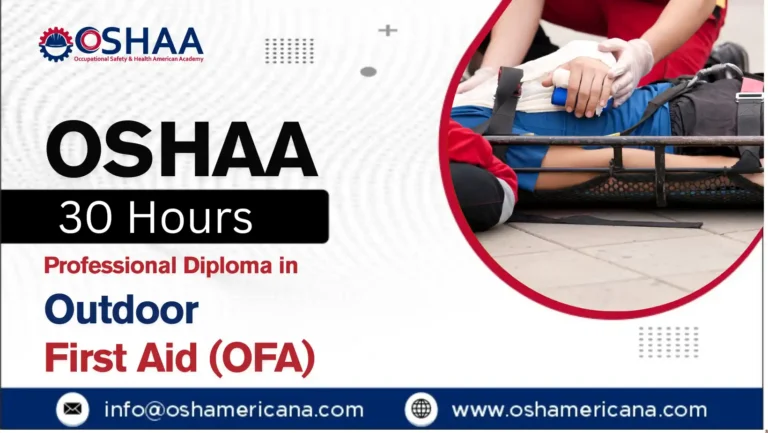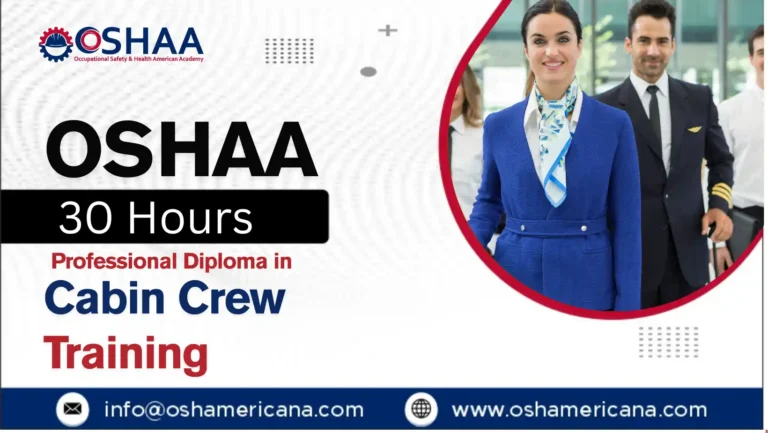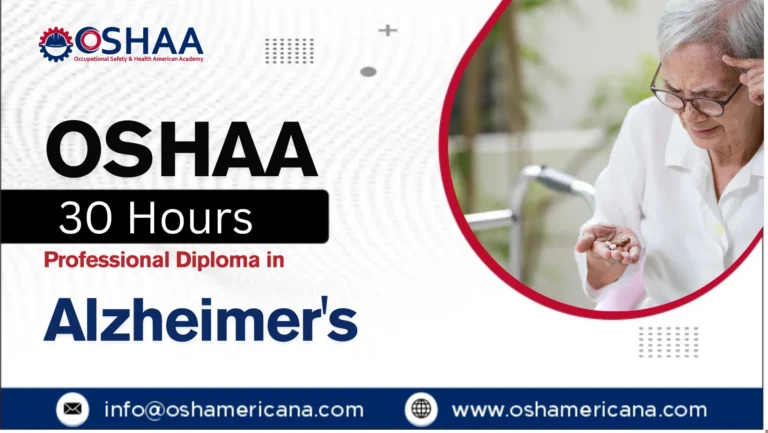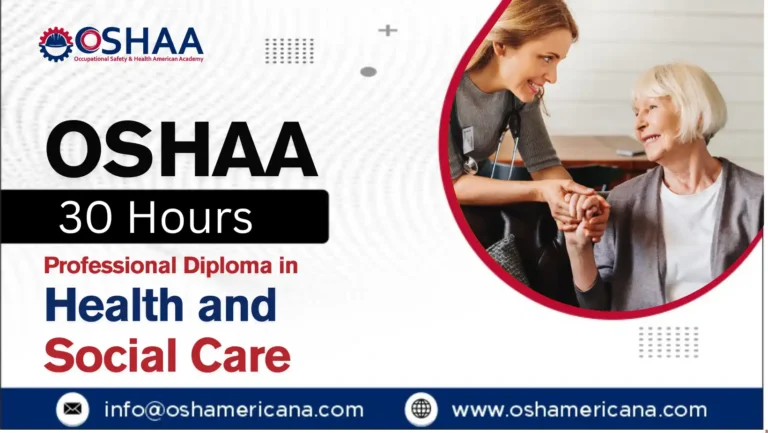Enhance your skills in child protection with the OSHAA 30-Hours Basics of Safeguarding Children, ensuring safety, compliance, and professional competence in childcare settings.
The OSHAA 30-Hours Basics of Safeguarding Children is a comprehensive professional training program designed to equip individuals with the essential knowledge and skills required to protect children from harm. In today’s diverse environments, ensuring the safety and well-being of children is a fundamental responsibility for teachers, social workers, childcare professionals, healthcare providers, and anyone interacting regularly with children. This course emphasizes the core principles of safeguarding, enabling participants to recognize, prevent, and respond effectively to abuse, neglect, and exploitation, while fostering a safe and supportive environment for every child.
Safeguarding children encompasses a proactive and responsive approach to child protection. Participants in the OSHAA 30-Hours Basics of Safeguarding Children course will gain a clear understanding of their roles and responsibilities in preventing harm, identifying risk factors, and intervening appropriately when children are at risk. The OSHAA 30-Hours Basics of Safeguarding Children course integrates international standards, regulatory compliance, and best practices to ensure learners can operate confidently in childcare, educational, and healthcare settings. By focusing on both preventative measures and effective response strategies, this training prepares professionals to uphold the highest standards of child protection and safety.
Through a combination of theoretical knowledge and practical guidance, the OSHAA 30-Hours Basics of Safeguarding Children course covers a wide range of safeguarding issues. Participants will learn to identify signs of abuse, understand legal and ethical obligations, and implement safe practices in daily interactions with children. The course also emphasizes communication skills, risk assessment, and creating child-centered policies that enhance safety and well-being. By completing this training, learners will develop the competence and confidence to act decisively, ensuring that children are protected in all environments under their care.
The OSHAA 30-Hours Basics of Safeguarding Children is an indispensable program for professionals who are responsible for the care, safety, and welfare of children. Beyond skill development, this course promotes professional growth, legal compliance, and a strong culture of child protection. By undertaking this professional training, participants not only fulfill a moral and legal responsibility but also gain the knowledge, tools, and confidence to create safe, nurturing, and compliant environments where children can thrive. Completing this course enhances professional credibility, strengthens workplace safety standards, and equips individuals with a robust foundation in child safeguarding practices that are recognized globally.
OSHAA 30-Hours Basics of Safeguarding Children
To enroll in the OSHAA 30-Hours Basics of Safeguarding Children, learners are expected to meet the following criteria:
- Age Requirement
- Participants must be at least 18 years of age to enroll in the OSHAA 30-Hours Basics of Safeguarding Children.
- Meeting the minimum age requirement ensures learners have the maturity and responsibility necessary to apply safeguarding principles effectively.
- The age criterion supports the professional readiness of participants to handle sensitive situations involving children safely.
- Educational Background
- A minimum of a secondary school diploma or equivalent is recommended for enrollment in the OSHAA 30-Hours Basics of Safeguarding Children.
- Higher education in related fields such as education, social work, healthcare, or childcare is advantageous and enhances comprehension of safeguarding concepts.
- Foundational education ensures learners can fully grasp the theoretical and practical components of the OSHAA 30-Hours Basics of Safeguarding Children course.
- Work Experience
- Prior experience working with children, in healthcare, or educational settings is recommended but not mandatory for the OSHAA 30-Hours Basics of Safeguarding Children.
- Learners with relevant experience will benefit from the practical applications and real-world scenarios presented during the course.
- Optional work experience allows newcomers to develop expertise, while experienced professionals can consolidate and update their safeguarding skills through the OSHAA 30-Hours Basics of Safeguarding Children training.
- English Proficiency
- Participants must be able to read, write, and speak English proficiently to understand all course materials, regulatory guidelines, and assessment requirements in the OSHAA 30-Hours Basics of Safeguarding Children.
- Proficiency in English ensures clear communication, accurate comprehension of safeguarding policies, and effective application of best practices in child protection.
- This requirement supports learners in achieving the full benefits of the OSHAA 30-Hours Basics of Safeguarding Children course while maintaining compliance with international standards.
The OSHAA 30-Hours Basics of Safeguarding Children is structured to provide advanced knowledge and professional skills for safeguarding children. Meeting these eligibility requirements ensures participants are well-prepared to fully engage with the course content, enhance their professional competence, and implement best practices in child protection confidently and effectively. This framework supports both regulatory compliance and the development of a strong safety culture for children in any environment.
Study Units
Learning Outcomes
The Learning Outcomes section for the OSHAA 30-Hours Basics of Safeguarding Children is designed to provide a clear roadmap of the knowledge, skills, and competencies participants will acquire throughout the course. This Course equips learners with advanced safeguarding skills, compliance knowledge, and the ability to lead safety initiatives effectively in any environment involving children. Participants will gain the professional expertise necessary to recognize, prevent, and respond to abuse and neglect, ensuring the protection and wellbeing of children while maintaining adherence to international regulatory standards.
- Introduction to Safeguarding Children (3 hours)
- Understand the fundamental principles and importance of safeguarding children in various settings.
- Identify the responsibilities of caregivers, educators, and healthcare professionals in maintaining child safety.
- Recognize the impact of safeguarding on child development and overall wellbeing.
- Develop awareness of global standards and best practices in child protection.
- Types and Signs of Abuse (4 hours)
- Identify different forms of abuse, including physical, emotional, sexual, and online exploitation.
- Recognize early warning signs and behavioral indicators of abuse in children.
- Analyze case studies to understand patterns and contexts of abuse.
- Apply knowledge to implement preventative measures and proactive interventions.
- Understanding Neglect (4 hours)
- Define neglect and its various manifestations, including physical, emotional, and educational neglect.
- Assess the long-term consequences of neglect on child development.
- Learn strategies to identify children at risk of neglect in different environments.
- Develop skills to implement support plans and safeguard vulnerable children effectively.
- Safeguarding Legislation and Policies (4 hours)
- Gain comprehensive knowledge of national and international safeguarding legislation.
- Understand organizational policies and procedures for child protection compliance.
- Learn how legal frameworks guide professional responsibilities in safeguarding.
- Apply policy knowledge to maintain compliance and minimize organizational risk.
- Child Protection Framework (4 hours)
- Explore the structures and systems in place to protect children within communities and institutions.
- Understand multi-agency collaboration and the role of statutory bodies in safeguarding.
- Develop skills to implement child protection frameworks effectively in professional settings.
- Learn to evaluate and improve safeguarding practices within organizations.
- The Role of Professionals in Safeguarding (4 hours)
- Define the responsibilities of professionals in identifying, preventing, and responding to child harm.
- Enhance communication and reporting skills when addressing safeguarding concerns.
- Understand the ethical obligations and duty of care in professional safeguarding roles.
- Develop leadership capabilities to promote a culture of child safety within organizations.
- Reporting Safeguarding Concerns (4 hours)
- Learn the correct procedures for reporting suspected abuse or neglect.
- Develop confidence in documenting concerns accurately and maintaining confidentiality.
- Understand legal and organizational requirements related to reporting safeguarding issues.
- Apply practical strategies to ensure timely and effective intervention for at-risk children.
- Safer Recruitment Practices (3 hours)
- Understand the principles of safe recruitment to prevent the hiring of individuals who may pose risks to children.
- Learn to implement background checks, references, and interview protocols effectively.
- Identify red flags and ensure compliance with safeguarding recruitment policies.
- Promote a proactive culture of safety and accountability in recruitment processes.
Upon completing the OSHAA 30-Hours Basics of Safeguarding Children, participants will possess the knowledge, practical skills, and professional competencies necessary to lead safeguarding initiatives confidently. This Course ensures learners are fully prepared to implement regulatory compliance measures, foster a strong safety culture, and protect children across educational, healthcare, and childcare environments. Graduates of this Course will be equipped to recognize risks, respond to safeguarding concerns effectively, and contribute to the creation of safe, supportive, and compliant organizations.
The OSHAA 30-Hours Basics of Safeguarding Children course provides extensive benefits for professionals, organizations, and stakeholders committed to ensuring the safety and wellbeing of children. This Course equips learners with essential knowledge, practical skills, and compliance awareness necessary to recognize, prevent, and respond to abuse and neglect in diverse settings. By completing this program, participants gain globally relevant expertise that enhances professional development, strengthens organizational safety practices, and ensures adherence to regulatory and legal requirements.
- Enhanced Knowledge of Child Protection
- Participants gain in-depth understanding of safeguarding principles, abuse types, neglect, and child protection frameworks.
- This knowledge enables professionals to identify risks proactively, enhancing the safety of children under their care.
- The OSHAA 30-Hours Basics of Safeguarding Children ensures learners can apply this knowledge effectively in real-world situations.
- Regulatory Compliance and Legal Awareness
- Learners understand national and international safeguarding legislation and policies.
- The Course provides practical guidance on adhering to regulatory requirements, reducing organizational liability.
- Professionals are prepared to maintain compliance with workplace safety standards and legal obligations.
- Improved Risk Assessment Skills
- Participants develop the ability to evaluate potential risks in childcare, educational, and healthcare settings.
- The Course teaches strategies to prevent harm and mitigate threats to child safety.
- Risk assessment capabilities foster safer environments and proactive incident prevention.
- Strengthened Incident Response Capabilities
- The Course equips learners to respond effectively to safeguarding concerns and emergencies.
- Professionals gain confidence in documenting, reporting, and managing incidents according to best practices.
- This ensures timely interventions and reduces the impact of potential harm on children.
- Professional Development and Career Advancement
- Completion of the OSHAA 30-Hours Basics of Safeguarding Children enhances professional credentials.
- Learners gain recognized qualifications that improve career prospects in childcare, education, and healthcare sectors.
- The Course supports ongoing professional growth and expertise in safeguarding.
- Enhanced Workplace Safety and Culture
- Organizations benefit from trained staff capable of promoting a culture of child safety and vigilance.
- The Course encourages proactive safeguarding measures, reducing incidents and enhancing overall operational safety.
- Employees become ambassadors of safety compliance and best practices.
- Effective Communication and Leadership Skills
- Participants learn to communicate safeguarding concerns clearly and professionally with colleagues, children, and parents.
- The Course develops leadership abilities for guiding teams in maintaining safe environments.
- Professionals can implement safeguarding strategies with authority and confidence.
- Improved Child Wellbeing and Support
- Learners acquire skills to create supportive environments that foster physical, emotional, and psychological wellbeing.
- The OSHAA 30-Hours Basics of Safeguarding Children emphasizes child-centered care approaches.
- Participants can actively contribute to positive developmental outcomes for children.
- Emergency Preparedness and Crisis Management
- The Course provides strategies for responding to urgent safeguarding situations effectively.
- Professionals gain competence in managing crises, ensuring swift and safe interventions.
- Preparedness reduces potential harm and reinforces organizational safety standards.
- Safer Recruitment and HR Practices
- Participants learn to implement recruitment practices that minimize risks of employing unsuitable personnel.
- The Course guides learners in vetting candidates, conducting background checks, and ensuring compliance with safeguarding policies.
- Organizations benefit from stronger, safer hiring practices that support child protection.
- Continuous Improvement and Policy Implementation
- Learners are trained to evaluate existing safeguarding policies and recommend improvements.
- The OSHAA 30-Hours Basics of Safeguarding Children encourages a culture of ongoing enhancement in child safety practices.
- This ensures organizations remain compliant, efficient, and responsive to emerging safeguarding challenges.
- Enhanced Collaboration and Multi-Agency Coordination
- Participants understand the importance of working with external agencies and stakeholders to safeguard children.
- The Course develops skills for coordinated approaches to child protection, improving outcomes.
- Professionals can effectively liaise with health, education, and social services sectors.
- Reduction in Legal and Operational Risks
- By ensuring compliance with safeguarding standards, participants minimize potential legal liabilities for themselves and their organizations.
- The Course emphasizes adherence to procedures that protect both children and institutions.
- Professionals gain the confidence to operate within ethical and legal frameworks.
- Increased Awareness of Emerging Safeguarding Issues
- The OSHAA 30-Hours Basics of Safeguarding Children educates learners on contemporary threats, including online safety and exploitation.
- Professionals can implement preventive measures and educational strategies for modern risks.
- This awareness supports the creation of adaptive, resilient safeguarding systems.
- Contribution to a Safer Society
- By completing this Course, participants actively contribute to building safer communities for children.
- The OSHAA 30-Hours Basics of Safeguarding Children empowers professionals to advocate for child safety beyond organizational boundaries.
- Graduates become informed, proactive custodians of child protection, fostering long-term societal benefits.
The OSHAA 30-Hours Basics of Safeguarding Children ensures participants gain a comprehensive, practical, and regulatory-aligned skillset. By completing this Course, learners enhance their professional capabilities, improve child safety standards, and contribute to a robust culture of safeguarding within their organizations and communities.
The OSHAA 30-Hours Basics of Safeguarding Children is specifically designed to meet the needs of professionals and individuals responsible for the care, safety, and wellbeing of children. This Course is highly relevant for industry professionals, educational institutions, healthcare providers, and childcare organizations seeking to strengthen safeguarding practices and ensure compliance with international safety standards. Participants will gain essential knowledge, practical skills, and regulatory insights that enable them to create safer environments for children, mitigate risks, and respond effectively to safeguarding concerns.
- Childcare Professionals
- Individuals working in daycare centers, nurseries, or early years education settings.
- The course enhances their ability to identify risks, prevent abuse, and implement safeguarding policies.
- Professionals gain practical skills to manage emergencies and ensure a safe environment for children.
- Supports adherence to workplace safety standards and OSHA-aligned safeguarding protocols.
- Teachers and Educators
- School teachers, teaching assistants, and educational coordinators responsible for children’s welfare.
- The course provides knowledge to recognize signs of abuse, neglect, and exploitation.
- Participants learn effective communication strategies and emergency response procedures.
- Enhances compliance with educational safeguarding regulations and professional standards.
- Healthcare Professionals
- Nurses, pediatricians, therapists, and medical staff involved in child care.
- The Course equips them with child-specific safeguarding knowledge and practical intervention techniques.
- Professionals can confidently implement safeguarding procedures while reducing risks in clinical settings.
- Supports global health and safety compliance, improving overall patient care.
- Social Workers and Child Protection Officers
- Individuals working in social services, child welfare agencies, and protective services.
- The Course provides essential tools to assess risk, manage cases, and report concerns effectively.
- Professionals develop skills to implement multi-agency safeguarding frameworks.
- Ensures alignment with legal and regulatory requirements for child protection.
- Parents and Guardians
- Parents, foster carers, and guardians seeking to enhance child safety at home or in community settings.
- The Course improves awareness of abuse and neglect, teaching practical prevention and intervention strategies.
- Participants gain confidence to safeguard children in everyday and emergency situations.
- Strengthens compliance with national safeguarding guidelines and best practices.
- Youth Workers and Mentors
- Professionals involved in youth programs, after-school clubs, and community centers.
- The Course teaches identification of potential risks and safeguarding strategies for group settings.
- Participants develop skills to manage child protection incidents and create safe environments.
- Supports organizational safety compliance and operational excellence in youth services.
- Volunteers in Child-Focused Organizations
- Individuals volunteering with NGOs, charities, and community programs focused on children.
- The Course provides essential safeguarding knowledge and practical skills for volunteer roles.
- Volunteers gain the confidence to act responsibly in child protection scenarios.
- Ensures volunteers adhere to organizational policies and legal safeguarding requirements.
- Educational Administrators and School Leaders
- Principals, headteachers, and administrative staff overseeing child-focused environments.
- The Course equips them with leadership knowledge to enforce safeguarding policies effectively.
- Participants develop skills in staff training, risk management, and compliance monitoring.
- Enhances organizational safety culture and alignment with OSHA-compliant safeguarding standards.
- Childcare Inspectors and Auditors
- Professionals responsible for evaluating childcare and educational settings.
- The Course provides tools to assess safeguarding practices, identify gaps, and recommend improvements.
- Participants gain knowledge to ensure compliance with regulatory and safety standards.
- Supports operational efficiency and continuous improvement in child-focused organizations.
- Policy Makers and Training Coordinators
- Individuals designing programs, policies, and training for child safety and protection.
- The Course offers insights into effective safeguarding frameworks, risk assessment, and incident management.
- Professionals enhance their ability to develop, implement, and evaluate safeguarding policies.
- Strengthens compliance with global child protection standards and improves professional development outcomes.
The OSHAA 30-Hours Basics of Safeguarding Children equips participants across all roles with advanced knowledge, practical skills, and recognized certification that enhance child protection, safety compliance, and operational efficiency. By completing this Course, learners gain the competence to lead safeguarding initiatives, ensure adherence to regulatory requirements, and foster a safe, supportive environment for children in every professional setting.







